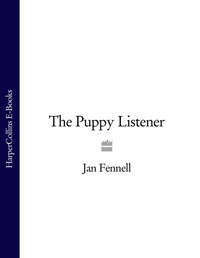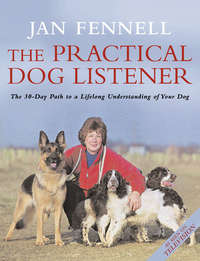
Полная версия
The Puppy Listener
A domestic dog is living in a very different social organisation – but it is still vital that the dog begins to get the information it will need to function within that organisation. And it is vital that that knowledge is imparted now, when its most important imprinting is happening. It is up to us, as humans, to perform the same role as the pack that would be its teachers in the wild.
HANDLING PUPPIES
It is around three weeks old that breeders should start handling puppies, getting them used to the sight, smells and sounds of humans. This is vitally important for the rest of the puppy’s development so from the outset the aim is for the puppy to associate human contact with warmth, comfort and above all safety. While a little stress is good for the dog’s development – making it ask ‘What happens now?’ – too much stress has to be avoided at all costs.
To pick up a puppy, follow these steps:
1. Crouch down to ground level.
2. Place your hands underneath the puppy and scoop it up gently but confidently.
3. Remaining in the crouched position, raise it up off the ground to eye level.
4. Reward the puppy by placing it in your arms, stroking it gently and making calm, reassuring noises.
If this is done correctly, the puppy will make the association that you are a safe zone. When it feels unsafe in the future and begins to ask questions about where it should go, you will already have provided one potential answer.
This is why you should never pick up a puppy by the scruff of its neck, as some people advocate. This habit is based on a misconception by humans who have seen dogs picking up their young with their teeth. They miss two important points: firstly, the dog clamps its teeth on the pup’s back area, not on the neck; and secondly, it only does so because it doesn’t have hands to do the job. If it did, it wouldn’t be using its teeth. We do have hands and we should use them. By picking the puppy up by the scruff of its neck, you are inflicting pain on it. This creates a totally negative association, which will be a barrier to you bonding with the dog in the days and weeks to come.
Carers who don’t interact with their puppies during this crucial phase of their development are losing valuable time. Indeed, there is strong scientific evidence that a puppy’s instinct to investigate and socialise is at its peak during this early five-week period, after which it begins to fall away. Dogs who haven’t been exposed to humans and their environment by the age of 14 weeks find it problematical to do so in later life.
Go through this picking-up process twice a day from the age of three weeks onwards. As the puppy gets to trust you more you can extend and develop this interaction. This will allow you to pave the way for its interaction with other humans, vets in particular.
1. Place the puppy on a raised surface, like a table. Make sure it is covered and stable, as sudden movement will frighten them.
2. Begin a little bit of grooming, running a very soft brush through its coat.
3. Begin placing your fingers in its mouth, so as to open the jaw and inspect the mouth.
4. Begin holding its head so as to inspect its ears.
5. Teach the puppy to roll on its side in a submissive position. This will achieve two things: preparing the dog for future visits to the vet and also underlining the dominance it has already begun to associate with you.
6. Get the puppy used to you touching its feet. A lot of dogs don’t like having their feet touched, so it’s a huge benefit to get over this hurdle early on. This is best done when the puppy is tired so it is easier to work with.
TEACHING RECOGNITION OF ITS NAME
The most important thing you want to instil in your dog during this first eight weeks is the belief that there is nothing threatening in a human voice. When you or anyone else speaks, you want the dog to associate the sound with all things warm and positive. It is too soon to start teaching it specific commands, such as ‘sit’ or ‘come’, but the puppy will soon have to learn some discipline and self-control. For now it is important that it delights in your company and that it makes a positive association with your voice.
There is one important thing you can do at the moment, and that is to get the puppy to recognise its own name. In doing this you are laying in place some important groundwork for when you get down to training it properly.
The first thing you need to do is choose a name. Once the puppy’s name has been chosen it’s a good idea to use it from the very first time you are picking it up and showing it affection at around three weeks of age. It will be possible to change the dog’s name when it moves home, but if it is destined for another home and you know the likely owner, it is helpful if they choose the name you start working with from an early stage.
The next thing to do is start addressing the puppy within its litter, using that name. At this point the dog doesn’t see itself as an individual so much as a litter member, so it is possible it may not respond immediately. But if it does, your goal is to get it to stop, look at you and – for the first time – ask ‘Are you talking to me?’
There are a few key points to remember when doing this.
• Eye contact is crucial. When you call one of the puppies they may all look at you but you must only look at the individual you are addressing.
• Make sure your eyes are soft and inviting; don’t glare or look anxious.
• When you call the name, do so in a happy way; the tone should be soft, as should the body language.
• If the dog comes to you on its own, praise it warmly, repeating the name.
• If the whole litter comes, make a point of only praising the one dog; you are also trying to teach the pups that it is not their name, and this will help reinforce that message.
The beauty of this is that it is something you can build on. When you are teaching the dog to make a positive association with something during weaning or toilet training, for instance, repeating the name warmly as you reward it will help.
All this should have a drip effect on the dog. It should soon recognise the distinctive sound of its own name, providing you – and its future owners – with a foundation on which to work.
WEANING
Between three and five weeks of age, the puppy is ready to be weaned off its mother’s milk.
In the wild, this is the point at which the alpha female will relinquish her duties as the sole provider of sustenance and take a back seat to the rest of the pack. A mother of domestic puppies behaves in this same instinctive way, standing up to feed rather than lying down, thereby allowing herself to move away if she feels she has finished or if she is being hurt by the puppy’s pin-sharp baby teeth or claws.
It will take the puppy around three weeks to make the transition off its mother’s teat. During that time it may still suckle and feed, but as the demands of her puppies slowly decrease, the female’s milk will dry up so owners will notice that feeding times shorten in length. During the early stages of weaning the puppy’s diet may be divided 50–50 between its mother’s milk and other food, but by the end of the sixth week a puppy should be eating independently of its mother.
Many people begin weaning with a cereal, such as porridge mixed with milk. Some opt for tinned puppy food. Others go for kibbles of ‘complete food’ made up of carefully selected ingredients that constitute an ideal diet. Many people opt for raw meat.
The puppy will by now have a full complement of teeth coming through, but their jaws are still too weak for it to crunch anything and its throat is still too narrow to swallow food of any size. It is vital that whatever food you choose to introduce, it is of the right consistency. Porridge with milk should be as smooth as possible, while kibbles should be soaked in cold water overnight then mixed in a food processor for better consistency. Tinned food must also be softened so that it is palatable for the puppy. If you go for the raw-meat option, make sure it is minced well.
Follow these instructions for the first feed.
1. Pick up the puppy gently, speaking to it softly. Don’t make any sudden movements.
2. Pinch together your thumb and third and fourth fingers. Scoop the food onto your fingers, then put it under the puppy’s nose for a moment or two so it can smell it.
3. How quickly it accepts the food depends on personality. Some will only need to smell it and they will be digging in, while others will be cautious and unsure. If they are enthusiastic, be careful they don’t bite. If they are reluctant, be patient.
4. When the puppy has eaten, stroke it softly with one finger and give it some gentle words of praise.
This is the first time the puppy will have associated you with the providing of food. It is vital that you make it a good association by taking things slowly and doing all you can to make it as pleasant an experience as possible. Time spent getting this right can make the difference between a relationship that works and one that doesn’t. Don’t rush it.
TOILETTING
Until now, as we have seen, the mother both stimulates defecation and cleans up afterwards. This is no longer the case. By the start of the third week, the puppy will have begun to make its first moves away from the whelping box. Generally the front of the box is removed around this time, allowing them to move a few feet away from their sleeping area towards the boundary of the den.
They will begin to defecate and urinate on their own. This new independence coincides with the mother’s gradual removal of herself from the scene.
A puppy of three to four weeks will urinate 12 or more times a day and will open its bowels five to six times a day.
At first the puppy will probably do its toiletting around the den. Dogs are by nature clean creatures so the puppy will try to put as much distance as it can between its sleeping and feeding area and its toilet area. You must ensure you have something in place for puppies to go to the toilet on. There are plenty of alternatives: newspapers or absorbent padding or perhaps wood shavings (make sure they are dust-free).
The puppy isn’t going to get to this area every time, of course, so during this phase it is vital you keep the bedding area immaculately clean. You can buy absorbent bedding that takes wetness through to the bottom. A lining of newspaper between this and the floor will provide another layer to take up moisture. This should be changed as often as need be, perhaps even two or three times a day during the early stage of toilet training.
Dogs prefer to do their toiletting in a natural environment so it is good for both you and your dog if you progress the training to a garden or outdoor area as soon as possible. You should start doing this at about four weeks of age. They should have got the hang of walking by then.
• Accompany the dog to the toilet first thing in the morning, after meals and when it wakes from a sleep.
• Stay with it in the garden or outdoor area. When you see it squatting, give it a food reward and use a word such as ‘empty’ or ‘clean dog’.
There are going to be occasions when it catches you out, so be careful to line the dog’s route from the sleeping area to the garden with whatever it is you are using to absorb the mess. The ideal thing would be a flap leading straight from the den to the garden.
If the puppy has accidents away from the toilet area, the important thing is not to chastise it. Clear it up without a word. The key to toilet training is making it a good association, so anything negative at this stage is unhelpful. With a positive association being built all the time, it won’t take the puppy long to make the connection between wanting to go to the toilet and going outside.
* * * * * * *
By eight weeks of age, the puppy will be ready to move on to a new home without its mother and siblings. The better the care it has received in these early weeks, the more easily it will cope with the trauma of the change of environment. In the next chapter, you’ll find advice for new owners on choosing a puppy at this stage.
Chapter 3 - Choosing your Dog
Before looking at the details of how to introduce a puppy into your home, it is important to discuss how you acquire a new dog. To my mind, there are only two sources from which we should buy dogs: respectable, responsible breeders and registered rescue centres or dogs’ homes.
There is, I know, a wide range of alternative sources – from pet shops and so-called licensed kennels, classified ads or even from a chance encounter with a seller in a pub or at a fairground.
The problem with buying from a stranger is obvious, in that you will have no comeback if anything goes wrong. A friend of mine once saw a batch of dogs for sale at a horse fair. There were no clues as to where these dogs had come from. Their owners had only one interest: making money. My friend was a soft touch and took pity on one dog in particular. During the next two years she spent more than £2,500 on vets bills, because it turned out the dog was riddled with worms and suffered from a variety of stomach problems. The crucial point here is that she had no way of seeking compensation from the people who sold her that dog. She didn’t even get a contact name.
This type of trade is sadly on the increase. The growth of so-called puppy farms, where dogs are bred in a factory-style environment, is something I abhor. Here in the UK the vast majority of pet dealers and licensed kennels are supplied by puppy farms, and owners who buy from them will often be allowed no more than 48 hours in which to return their dogs. How on earth is anyone supposed to decide whether they will be able to share their life with a dog in that space of time? Health problems may not have emerged within that period, and the dog’s true personality might be masked beneath its anxiety about the new surroundings.
It is my firm belief that if at all possible an owner should be able to meet – at least – the puppy’s mother before taking the dog away. This is something I will explain in more detail in a moment. You should be able to visit the breeder and see the puppy interacting with its mother and siblings. Be suspicious if you can’t; in puppy farms, mother and pups are separated early on. The absence of the mother may mean that the seller is a third party, whose motives are purely to do with money rather than the welfare of the dogs in their protection.
No reputable breeder or rescue centre would sell a dog without guaranteeing that the owner could return the animal to them if they were unable to keep the dog for whatever reason. The dog cannot lose under this arrangement. If it fits into a happy home it will enjoy a long and hopefully rewarding life there. If not, it will return to a place where its best interests are safeguarded.
Owners who leave themselves with no comeback are not able to return an unwanted dog. Many will, of course, ensure they are given good homes but, sadly, many more will not. And that is something I cannot condone.
BUYING A PUPPY
Falling in love with a puppy is the easiest thing in the world. We’ve all experienced the aaaaaaah factor, that moment when we’ve stared for the first time into the saucer-sized eyes of a cute young dog and gone hopelessly gooey. It’s for this reason that I recommend people begin their search for a puppy by steering clear of these charmers to begin with.
We know that owners are going to fall head over heels in love with the puppy. It’s a given. Far better for them to deal with the realities before beginning the romance. And the best way to do this is by first meeting the parents.
Producing a litter of puppies involves a collaboration between the human breeder and the dogs. The dogs deliver this new life into the world, but it is the former who must shoulder the ultimate responsibility. I passionately believe that the best way to assess whether a dog is coming from a good home is by getting to know both sets of ‘parents’ – human and canine.
Given that many breeders go to stud to begin their litters, it is more than likely that only the mother will be available. Her personality, temperament and general demeanour will reveal much. If you are able to meet the father as well, this will provide the clearest possible idea of the sort of dog its offspring is going to become.
Just as importantly, the attitude of the breeder is highly revealing. Is their home well-kept? How does the breeder behave towards the dogs? The extent to which the breeder interrogates all potential new owners is a good indication of the quality of the home. You should expect to be grilled by a good breeder. Personally, I insist on knowing as much as I can about anyone who wants to take one of my puppies into their home. It’s like an adoption society; reputable breeders – and registered rescue centres – are very careful about where they place the ‘children’ entrusted to their care. A good breeder is responsible for innocent young lives and they should want to know everything about the home into which they are considering releasing the puppy. They should always ask what the domestic situation is at home.
• Are there people around all day to look after the dog?
• Are there many small children in the home?
• Have they owned this type of dog – or indeed any dog – before?
• Have the prospective owners thought about whether the particular breed is right for their home?
The fact that the breeder, or rescue centre, asks these questions should be seen as a positive sign. If they are not asking these questions, they are probably more interested in making a sale than the dog’s welfare and should, therefore, be treated with caution.
By the same token, a good breeder should be open to questions from a potential owner. They should be willing to reveal anything and everything about the dog’s history and background – from the details of its parentage and its age, to its favourite food and toys. I’ve suggested a list of questions to ask below. Again, owners should be wary of anyone who is vague or unhappy about answering these questions.
Questions to ask a breeder or rescue centre
• What is the dog’s background?
• Who are its parents (if known)? Can you meet them?
• What age is the dog?
• Favourite foods?
• At what times is it fed, and what quantities of food?
• Favourite toys?
• What medical checks has it had?
• Has it been wormed?
• Has it had any vaccinations?
• Has it had its eye test to check for inherited conditions?
• Have any health problems been identified?
• Are there any procedures required by the breed standard, such as removal of a dew claw? If so, have they been done?
• Do its parents suffer from any hereditary problems that could have been passed on?
• Can you have the breed certification documents?
Potential owners should be particularly careful about checking for hereditary problems within some breeds. Cavalier King Charles Spaniels are prone to heart problems, for instance. Long-backed breeds like Basset Hounds and Dachshunds have a tendency to suffer from back pain and slipped discs. In German Shepherds and Labradors, potential buyers should look out for hip dysplasia, a genetic problem in which the ball and socket joint of the hip can be deformed or even non-existent. It is a condition that is extremely painful and ultimately crippling for dogs that are afflicted and something that good breeders monitor closely. Dogs are routinely x-rayed at the age of one and given a ‘hip score’ – which ranges from zero for perfect hips to 18 and higher, a mark which indicates the dog should not be used for breeding. Signs of hip dysplasia can manifest themselves even earlier than this, so it is wise to observe puppies for any tell-tale signs of discomfort in walking, such as ‘hopping’ when they walk.
So as to make informed and appropriate choices, potential owners are advised to research the breeds they are interested in. This is easily done through the Kennel Club or its equivalent organisation overseas and after that the various breed experts. The importance of this cannot be over-stressed. No one goes out to make a major purchase such as a new car or a house without researching the subject thoroughly. When they choose a dog, owners are introducing into the family a new member that will hopefully remain with them for 12 to 14 years. It is not something to be taken lightly.
BREEDS APART: WHAT DIFFERENT DOGS DEMAND FROM THEIR OWNERS
Hundreds of years of selective breeding by humans has produced a bewildering array of different dogs. And, for all their essential similarities, these dogs bring with them their own set of special needs. Some will need more exercise than others. Some will need much more grooming. Others will have a significantly shorter lifespan and will, therefore, incur the inevitable medical costs associated with old age that much sooner. Size is a factor too. The giant breeds need enough space in which to move and grow. Anyone considering acquiring a dog should take all these factors into consideration.
The demands of the different breeds fall into the following broad categories.
PHYSICAL DEMANDS
Some dogs have been bred to be more athletic and energetic than others. Gundogs or sporting dogs, for instance, will tend to demand a lot of exercise. These Springers, Pointers and Setters were, after all, bred to work on the hunt and are able to run for long periods during a normal hunting day. They also tend to love water and may be drawn to retrieve or chase birds, because of generations of breeding. Similarly, pastoral or herding breeds tend to be attracted to other species of animals and may instinctively try to herd them. Not every owner is going to have a flock of sheep for their Collie or German Shepherd to round up, but they should be prepared to give these dogs a proper outlet for their considerable energies. They need homes that are going to be up to the challenge of giving them plenty of exercise and play time.
At the other end of the scale, the toy dog group includes many breeds that were designed to provide little more than companionship and warmth, sometimes literally. Toy breeds such as the Chihuahua, Pekingese, Pomeranian and Maltese don’t need huge amounts of exercise.
SPATIAL DEMANDS
The size of a dog is a factor that needs to be taken into consideration. While toy dogs will not take up much space, large working dogs will fill almost any space they occupy. If they are active dogs as well, this could cause owners problems in a small or restrictive space. Everyone, of course, has the right to own the breed of their choice, but allowances should be made for the living space they require.
GROOMING DEMANDS
Dogs are naturally clean animals, and take a great deal of care of their condition. As a result, some breeds require next to no grooming. Smooth-coated dogs such as the Labrador Retriever or the Great Dane, for instance, are low maintenance compared to other breeds. By contrast, there are some breeds that have been bred purely for their look and consequently have exceedingly long, high-maintenance coats. Breeds that spring to mind here include Afghan Hounds, Spaniels, Old English Sheepdogs, the Bichon Frise and Poodle breeds. Dogs in the Terrier group can also require ‘hand stripping’ (see page 32) to keep their coats looking good.
DOGS WITH MEDICAL/LIFESPAN DEMANDS
The average life expectancy of different breeds varies enormously. Working breeds tend to be bigger dogs so they usually live shorter lives. Smaller toy dogs, on the other hand, tend to live to more advanced ages. Dogs with shorter lifespans are going to need medical care earlier than those with longer lifespans. Old age tends to be the period when the most visits to the vet are required. If the dog isn’t going to live much beyond seven years then, inevitably, this period is going to arrive sooner than if they live to 15 or beyond. They need owners who are willing to meet this challenge.









